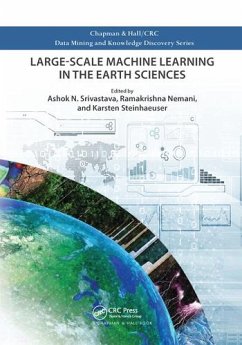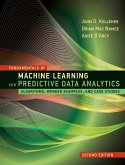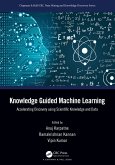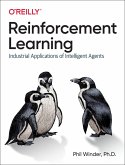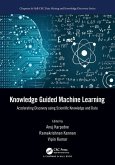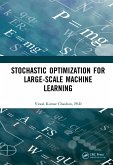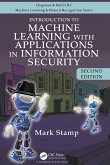Large-Scale Machine Learning in the Earth Sciences
Herausgeber: Srivastava, Ashok N.; Nemani, Ramakrishna; Steinhaeuser, Karsten
Large-Scale Machine Learning in the Earth Sciences
Herausgeber: Srivastava, Ashok N.; Nemani, Ramakrishna; Steinhaeuser, Karsten
- Broschiertes Buch
- Merkliste
- Auf die Merkliste
- Bewerten Bewerten
- Teilen
- Produkt teilen
- Produkterinnerung
- Produkterinnerung
Large-scale machine learning could prove highly beneficial in the study of earth science, a broad, multidisciplinary field of study that generates huge amounts of data. This book is the first to tackle the subject, covering significant issues in earth science and large-scale machine learning techniques with well-known authorities in the field.
Andere Kunden interessierten sich auch für
![Fundamentals of Machine Learning for Predictive Data Analytics Fundamentals of Machine Learning for Predictive Data Analytics]() John D. KelleherFundamentals of Machine Learning for Predictive Data Analytics73,99 €
John D. KelleherFundamentals of Machine Learning for Predictive Data Analytics73,99 €![Knowledge Guided Machine Learning Knowledge Guided Machine Learning]() Knowledge Guided Machine Learning146,99 €
Knowledge Guided Machine Learning146,99 €![Reinforcement Learning Reinforcement Learning]() Phil Winder Ph.D.Reinforcement Learning47,99 €
Phil Winder Ph.D.Reinforcement Learning47,99 €![The Car That Knew Too Much: Can a Machine Be Moral? The Car That Knew Too Much: Can a Machine Be Moral?]() Jean-Francois BonnefonThe Car That Knew Too Much: Can a Machine Be Moral?24,99 €
Jean-Francois BonnefonThe Car That Knew Too Much: Can a Machine Be Moral?24,99 €![Knowledge Guided Machine Learning Knowledge Guided Machine Learning]() Knowledge Guided Machine Learning99,99 €
Knowledge Guided Machine Learning99,99 €![Stochastic Optimization for Large-scale Machine Learning Stochastic Optimization for Large-scale Machine Learning]() Vinod Kumar ChauhanStochastic Optimization for Large-scale Machine Learning220,99 €
Vinod Kumar ChauhanStochastic Optimization for Large-scale Machine Learning220,99 €![Introduction to Machine Learning with Applications in Information Security Introduction to Machine Learning with Applications in Information Security]() Mark StampIntroduction to Machine Learning with Applications in Information Security95,99 €
Mark StampIntroduction to Machine Learning with Applications in Information Security95,99 €-
-
-
Large-scale machine learning could prove highly beneficial in the study of earth science, a broad, multidisciplinary field of study that generates huge amounts of data. This book is the first to tackle the subject, covering significant issues in earth science and large-scale machine learning techniques with well-known authorities in the field.
Hinweis: Dieser Artikel kann nur an eine deutsche Lieferadresse ausgeliefert werden.
Hinweis: Dieser Artikel kann nur an eine deutsche Lieferadresse ausgeliefert werden.
Produktdetails
- Produktdetails
- Chapman & Hall/CRC Data Mining and Knowledge Discovery Series
- Verlag: Taylor & Francis Ltd
- Seitenzahl: 238
- Erscheinungstermin: 30. Juni 2020
- Englisch
- Abmessung: 178mm x 254mm x 23mm
- Gewicht: 508g
- ISBN-13: 9780367573232
- ISBN-10: 0367573237
- Artikelnr.: 62479283
- Herstellerkennzeichnung
- Libri GmbH
- Europaallee 1
- 36244 Bad Hersfeld
- 06621 890
- Chapman & Hall/CRC Data Mining and Knowledge Discovery Series
- Verlag: Taylor & Francis Ltd
- Seitenzahl: 238
- Erscheinungstermin: 30. Juni 2020
- Englisch
- Abmessung: 178mm x 254mm x 23mm
- Gewicht: 508g
- ISBN-13: 9780367573232
- ISBN-10: 0367573237
- Artikelnr.: 62479283
- Herstellerkennzeichnung
- Libri GmbH
- Europaallee 1
- 36244 Bad Hersfeld
- 06621 890
Ashok N. Srivastava, Ph.D. is the VP of Data and Artificial Intelligence Systems and the Chief Data Scientist at Verizon. He leads a new research and development center in Palo Alto focusing on building products and technologies powered by big data, large-scale machine learning, and analytics. He is an Adjunct Professor at Stanford University in the Electrical Engineering Department and is the Editor-in-Chief of the AIAA Journal of Aerospace Information Systems. Dr. Srivastava is a Fellow of the IEEE, the American Association for the Advancement of Science (AAAS), and the American Institute of Aeronautics and Astronautics (AIAA). He is the author of over 100 research articles, has edited 4 books, has 5 patents awarded, and over 30 under file. He has won numerous awards including the IEEE Computer Society Technical Achievement Award for "pioneering contributions to intelligent information systems," the NASA Exceptional Achievement Medal for contributions to state-of-the-art data mining and analysis, the NASA Honor Award for Outstanding Leadership, the NASA Distinguished Performance Award, several NASA Group Achievement Awards, the Distinguished Engineering Alumni Award from UC Boulder, the IBM Golden Circle Award, and the Department of Education Merit Fellowship. Dr. Ramakrishna Nemani is a senior Earth scientist with the NASA Advanced Supercomputing division at Ames Research Center, California, USA. He leads NASA's efforts in ecological forecasting to understand the impacts of the impending climatic changes on Earth's ecosystems and in collaborative computing, bringing scientists together with big data and supercomputing to provide insights into how our planet is changing and the forces underlying such changes. He has published over 190 papers on a variety of topics including remote sensing, global ecology, ecological forecasting, climatology and scientific computing with over 28000 citations. He served on the science teams of several missions including Landsat-8, NPP, EOS/MODIS, ALOS-2 and GCOM-C. He has received numerous awards from NASA including the exceptional scientific achievement medal in 2008, exceptional achievement medal in 2011, outstanding leadership medal in 2012 and eight group achievement awards. Karsten Steinhaeuser, Ph.D. is a Research Scientist affiliated with the Department of Computer Science & Engineering at the University of Minnesota and a Data Scientist with Progeny Systems Corporation. His research centers around data mining and machine learning, in particular construction and analysis of complex networks, with applications in diverse domains including climate, ecology, social networks, time series analysis, and computer vision. He is actively involved in shaping an emerging research area called climate informatics, which lies at the intersection of computer science and climate sciences, and his interests are more generally in interdisciplinary research and scientific problems relating to climate and sustainability. Dr. Steinhaeuser has been awarded one patent and has authored several book chapters as well as numerous peer reviewed articles and papers on these topics. His work has been recognized with multiple awards including two Oak Ridge National Laboratory Significant Event Awards for "Novel Analyses of the Simulation Results from the CCSM 3.0 Climate Model" and "Science Support for a Climate Change War Game and Follow-Up Support to the US Department of Defense."
Computer science. Ecosystems. Climate/hydrology. Climate/landuse.
Climate/carbon. Machine learning. Earth science. Estimation and bias
correction in aerosols. Land cover monitoring and change detection.
Rainfall prediction. Mining spatio-temporal data sets. Climate systems
using earth science models. Ocean eddy monitoring. Class imbalance in earth
science. Big data and petascale climate science. Machine learning of
precipitation forecasts. Forest fire mapping. Morphological neural networks
for hyperspectral data using HPC. Machine learning applications for biomass
assessments. Grid computing for remote sensing applications. Deep learning
for very high resolution imagery classification.
Climate/carbon. Machine learning. Earth science. Estimation and bias
correction in aerosols. Land cover monitoring and change detection.
Rainfall prediction. Mining spatio-temporal data sets. Climate systems
using earth science models. Ocean eddy monitoring. Class imbalance in earth
science. Big data and petascale climate science. Machine learning of
precipitation forecasts. Forest fire mapping. Morphological neural networks
for hyperspectral data using HPC. Machine learning applications for biomass
assessments. Grid computing for remote sensing applications. Deep learning
for very high resolution imagery classification.
Computer science. Ecosystems. Climate/hydrology. Climate/landuse.
Climate/carbon. Machine learning. Earth science. Estimation and bias
correction in aerosols. Land cover monitoring and change detection.
Rainfall prediction. Mining spatio-temporal data sets. Climate systems
using earth science models. Ocean eddy monitoring. Class imbalance in earth
science. Big data and petascale climate science. Machine learning of
precipitation forecasts. Forest fire mapping. Morphological neural networks
for hyperspectral data using HPC. Machine learning applications for biomass
assessments. Grid computing for remote sensing applications. Deep learning
for very high resolution imagery classification.
Climate/carbon. Machine learning. Earth science. Estimation and bias
correction in aerosols. Land cover monitoring and change detection.
Rainfall prediction. Mining spatio-temporal data sets. Climate systems
using earth science models. Ocean eddy monitoring. Class imbalance in earth
science. Big data and petascale climate science. Machine learning of
precipitation forecasts. Forest fire mapping. Morphological neural networks
for hyperspectral data using HPC. Machine learning applications for biomass
assessments. Grid computing for remote sensing applications. Deep learning
for very high resolution imagery classification.

